Individual Nursing Report: Research Critique of Medication Errors
VerifiedAdded on 2020/07/22
|9
|2021
|37
Report
AI Summary
This individual nursing report critically analyzes two research articles focused on reducing medication errors in healthcare settings. The first article, "A Back to Basics Approach to reduce medication errors," examines the effectiveness of reinforcing fundamental medication procedures in the emergency department to minimize errors. The report discusses the aims, methods, results, and trustworthiness of this intervention, highlighting the importance of educational programs for nurses. The second article, "Effectiveness of a ‘Do not interrupt’ bundled intervention," investigates strategies to reduce interruptions during medication administration. The report evaluates the impact of a 'Do not interrupt' policy and related interventions on minimizing non-medication interruptions and improving patient safety. The report concludes by emphasizing the importance of continuous improvement in medication safety through sustainable interruption reduction strategies. The report draws on the aims, results, measurement validity, and trustworthiness of the studies to provide a comprehensive overview of medication error reduction strategies.
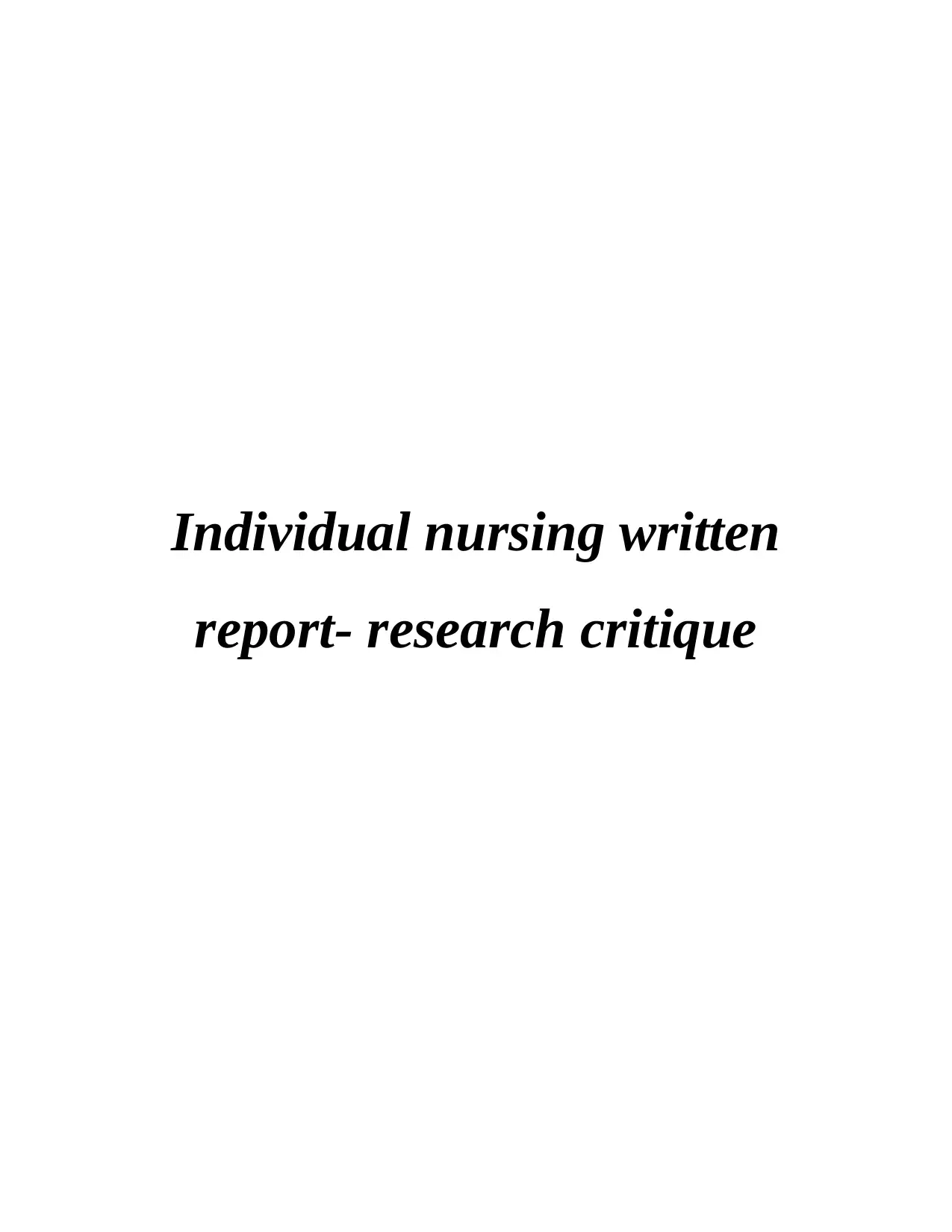
Individual nursing written
report- research critique
report- research critique
Paraphrase This Document
Need a fresh take? Get an instant paraphrase of this document with our AI Paraphraser
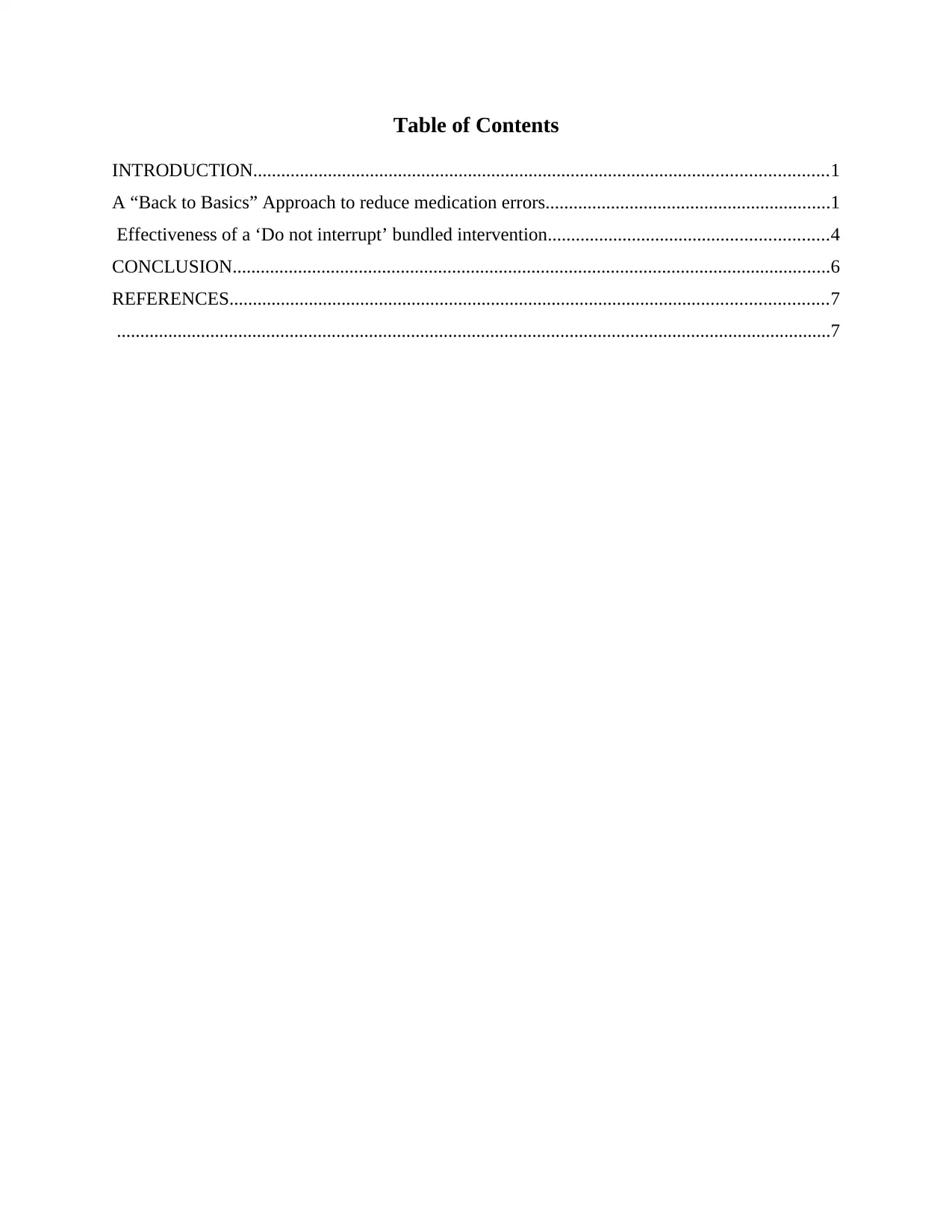
Table of Contents
INTRODUCTION...........................................................................................................................1
A “Back to Basics” Approach to reduce medication errors.............................................................1
Effectiveness of a ‘Do not interrupt’ bundled intervention............................................................4
CONCLUSION................................................................................................................................6
REFERENCES................................................................................................................................7
.........................................................................................................................................................7
INTRODUCTION...........................................................................................................................1
A “Back to Basics” Approach to reduce medication errors.............................................................1
Effectiveness of a ‘Do not interrupt’ bundled intervention............................................................4
CONCLUSION................................................................................................................................6
REFERENCES................................................................................................................................7
.........................................................................................................................................................7
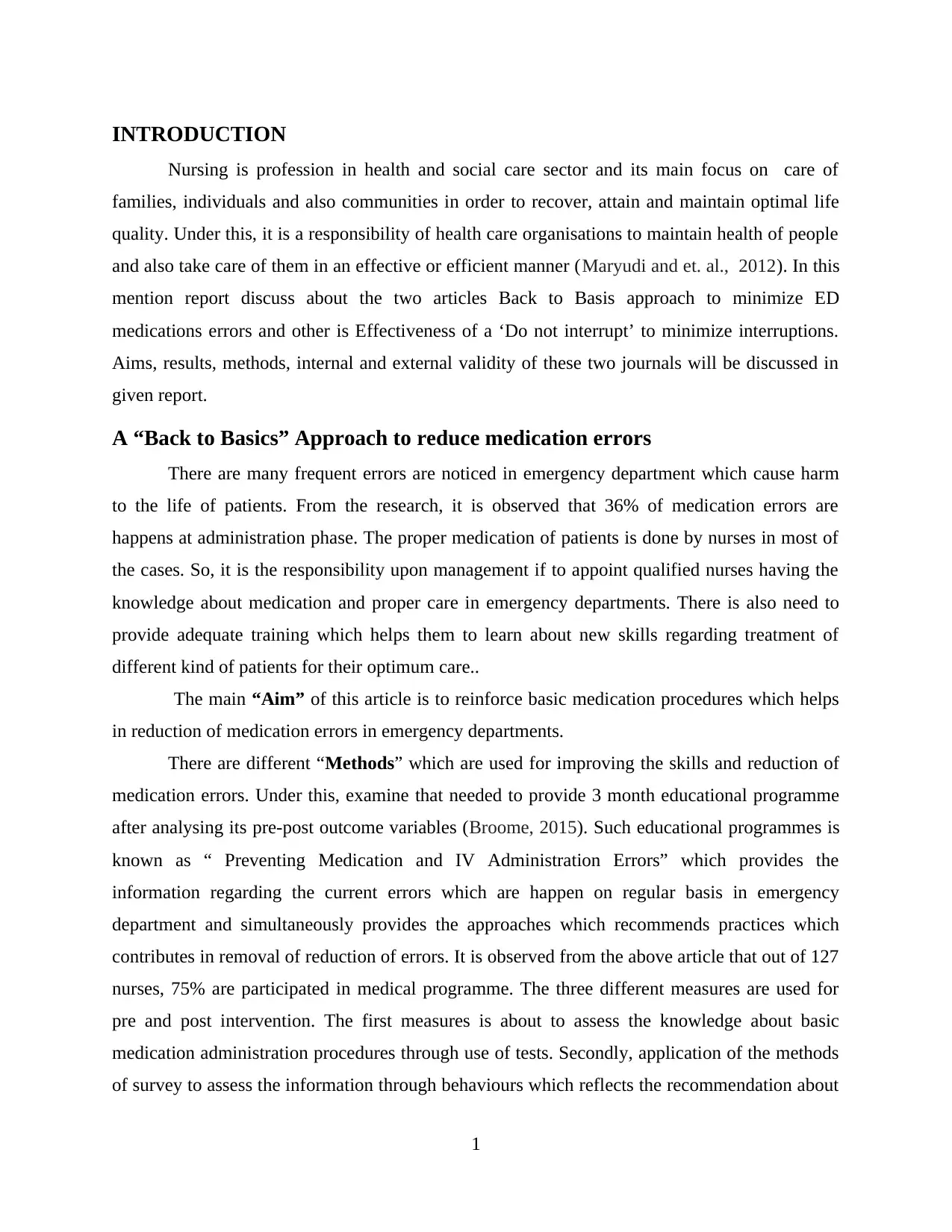
INTRODUCTION
Nursing is profession in health and social care sector and its main focus on care of
families, individuals and also communities in order to recover, attain and maintain optimal life
quality. Under this, it is a responsibility of health care organisations to maintain health of people
and also take care of them in an effective or efficient manner (Maryudi and et. al., 2012). In this
mention report discuss about the two articles Back to Basis approach to minimize ED
medications errors and other is Effectiveness of a ‘Do not interrupt’ to minimize interruptions.
Aims, results, methods, internal and external validity of these two journals will be discussed in
given report.
A “Back to Basics” Approach to reduce medication errors
There are many frequent errors are noticed in emergency department which cause harm
to the life of patients. From the research, it is observed that 36% of medication errors are
happens at administration phase. The proper medication of patients is done by nurses in most of
the cases. So, it is the responsibility upon management if to appoint qualified nurses having the
knowledge about medication and proper care in emergency departments. There is also need to
provide adequate training which helps them to learn about new skills regarding treatment of
different kind of patients for their optimum care..
The main “Aim” of this article is to reinforce basic medication procedures which helps
in reduction of medication errors in emergency departments.
There are different “Methods” which are used for improving the skills and reduction of
medication errors. Under this, examine that needed to provide 3 month educational programme
after analysing its pre-post outcome variables (Broome, 2015). Such educational programmes is
known as “ Preventing Medication and IV Administration Errors” which provides the
information regarding the current errors which are happen on regular basis in emergency
department and simultaneously provides the approaches which recommends practices which
contributes in removal of reduction of errors. It is observed from the above article that out of 127
nurses, 75% are participated in medical programme. The three different measures are used for
pre and post intervention. The first measures is about to assess the knowledge about basic
medication administration procedures through use of tests. Secondly, application of the methods
of survey to assess the information through behaviours which reflects the recommendation about
1
Nursing is profession in health and social care sector and its main focus on care of
families, individuals and also communities in order to recover, attain and maintain optimal life
quality. Under this, it is a responsibility of health care organisations to maintain health of people
and also take care of them in an effective or efficient manner (Maryudi and et. al., 2012). In this
mention report discuss about the two articles Back to Basis approach to minimize ED
medications errors and other is Effectiveness of a ‘Do not interrupt’ to minimize interruptions.
Aims, results, methods, internal and external validity of these two journals will be discussed in
given report.
A “Back to Basics” Approach to reduce medication errors
There are many frequent errors are noticed in emergency department which cause harm
to the life of patients. From the research, it is observed that 36% of medication errors are
happens at administration phase. The proper medication of patients is done by nurses in most of
the cases. So, it is the responsibility upon management if to appoint qualified nurses having the
knowledge about medication and proper care in emergency departments. There is also need to
provide adequate training which helps them to learn about new skills regarding treatment of
different kind of patients for their optimum care..
The main “Aim” of this article is to reinforce basic medication procedures which helps
in reduction of medication errors in emergency departments.
There are different “Methods” which are used for improving the skills and reduction of
medication errors. Under this, examine that needed to provide 3 month educational programme
after analysing its pre-post outcome variables (Broome, 2015). Such educational programmes is
known as “ Preventing Medication and IV Administration Errors” which provides the
information regarding the current errors which are happen on regular basis in emergency
department and simultaneously provides the approaches which recommends practices which
contributes in removal of reduction of errors. It is observed from the above article that out of 127
nurses, 75% are participated in medical programme. The three different measures are used for
pre and post intervention. The first measures is about to assess the knowledge about basic
medication administration procedures through use of tests. Secondly, application of the methods
of survey to assess the information through behaviours which reflects the recommendation about
1
⊘ This is a preview!⊘
Do you want full access?
Subscribe today to unlock all pages.

Trusted by 1+ million students worldwide
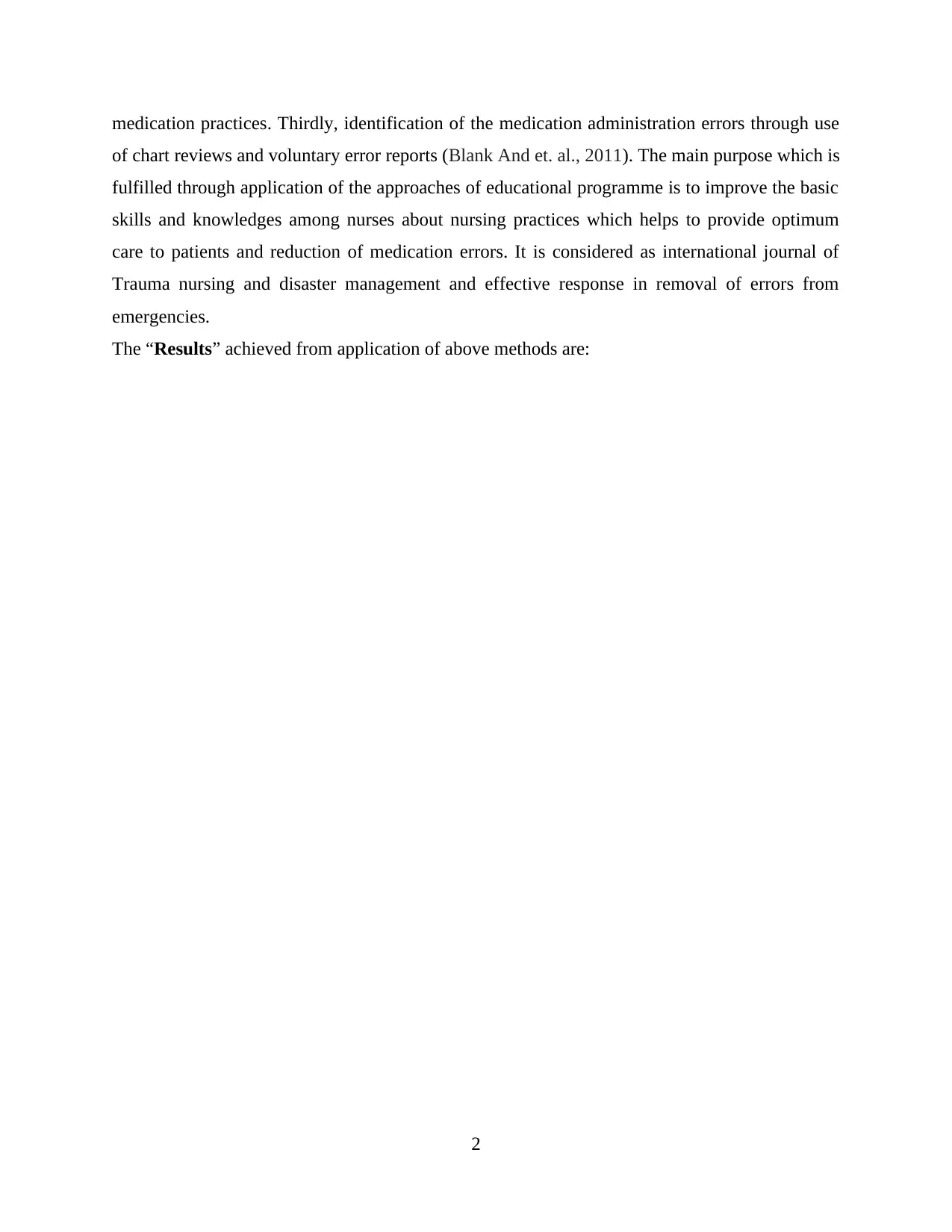
medication practices. Thirdly, identification of the medication administration errors through use
of chart reviews and voluntary error reports (Blank And et. al., 2011). The main purpose which is
fulfilled through application of the approaches of educational programme is to improve the basic
skills and knowledges among nurses about nursing practices which helps to provide optimum
care to patients and reduction of medication errors. It is considered as international journal of
Trauma nursing and disaster management and effective response in removal of errors from
emergencies.
The “Results” achieved from application of above methods are:
2
of chart reviews and voluntary error reports (Blank And et. al., 2011). The main purpose which is
fulfilled through application of the approaches of educational programme is to improve the basic
skills and knowledges among nurses about nursing practices which helps to provide optimum
care to patients and reduction of medication errors. It is considered as international journal of
Trauma nursing and disaster management and effective response in removal of errors from
emergencies.
The “Results” achieved from application of above methods are:
2
Paraphrase This Document
Need a fresh take? Get an instant paraphrase of this document with our AI Paraphraser
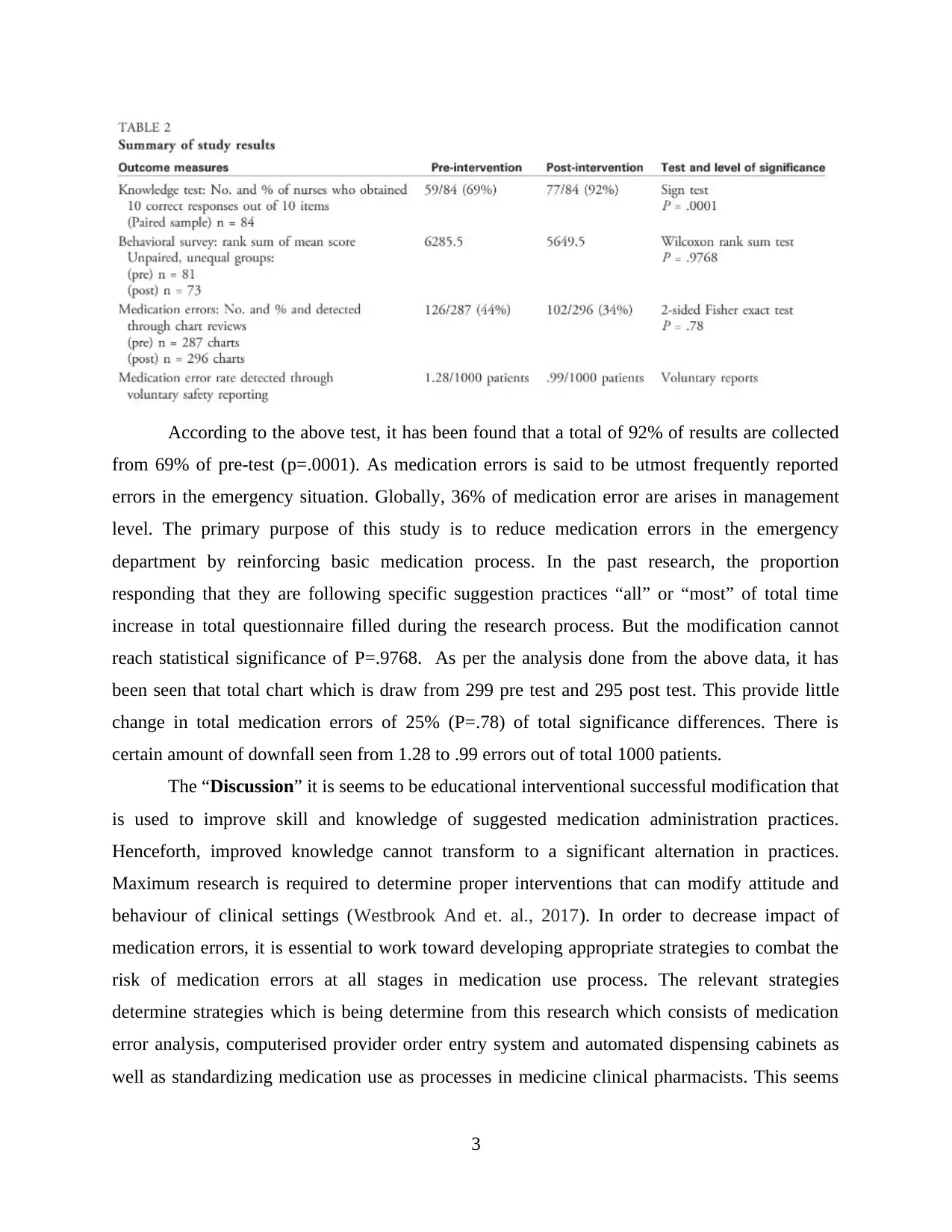
According to the above test, it has been found that a total of 92% of results are collected
from 69% of pre-test (p=.0001). As medication errors is said to be utmost frequently reported
errors in the emergency situation. Globally, 36% of medication error are arises in management
level. The primary purpose of this study is to reduce medication errors in the emergency
department by reinforcing basic medication process. In the past research, the proportion
responding that they are following specific suggestion practices “all” or “most” of total time
increase in total questionnaire filled during the research process. But the modification cannot
reach statistical significance of P=.9768. As per the analysis done from the above data, it has
been seen that total chart which is draw from 299 pre test and 295 post test. This provide little
change in total medication errors of 25% (P=.78) of total significance differences. There is
certain amount of downfall seen from 1.28 to .99 errors out of total 1000 patients.
The “Discussion” it is seems to be educational interventional successful modification that
is used to improve skill and knowledge of suggested medication administration practices.
Henceforth, improved knowledge cannot transform to a significant alternation in practices.
Maximum research is required to determine proper interventions that can modify attitude and
behaviour of clinical settings (Westbrook And et. al., 2017). In order to decrease impact of
medication errors, it is essential to work toward developing appropriate strategies to combat the
risk of medication errors at all stages in medication use process. The relevant strategies
determine strategies which is being determine from this research which consists of medication
error analysis, computerised provider order entry system and automated dispensing cabinets as
well as standardizing medication use as processes in medicine clinical pharmacists. This seems
3
from 69% of pre-test (p=.0001). As medication errors is said to be utmost frequently reported
errors in the emergency situation. Globally, 36% of medication error are arises in management
level. The primary purpose of this study is to reduce medication errors in the emergency
department by reinforcing basic medication process. In the past research, the proportion
responding that they are following specific suggestion practices “all” or “most” of total time
increase in total questionnaire filled during the research process. But the modification cannot
reach statistical significance of P=.9768. As per the analysis done from the above data, it has
been seen that total chart which is draw from 299 pre test and 295 post test. This provide little
change in total medication errors of 25% (P=.78) of total significance differences. There is
certain amount of downfall seen from 1.28 to .99 errors out of total 1000 patients.
The “Discussion” it is seems to be educational interventional successful modification that
is used to improve skill and knowledge of suggested medication administration practices.
Henceforth, improved knowledge cannot transform to a significant alternation in practices.
Maximum research is required to determine proper interventions that can modify attitude and
behaviour of clinical settings (Westbrook And et. al., 2017). In order to decrease impact of
medication errors, it is essential to work toward developing appropriate strategies to combat the
risk of medication errors at all stages in medication use process. The relevant strategies
determine strategies which is being determine from this research which consists of medication
error analysis, computerised provider order entry system and automated dispensing cabinets as
well as standardizing medication use as processes in medicine clinical pharmacists. This seems
3
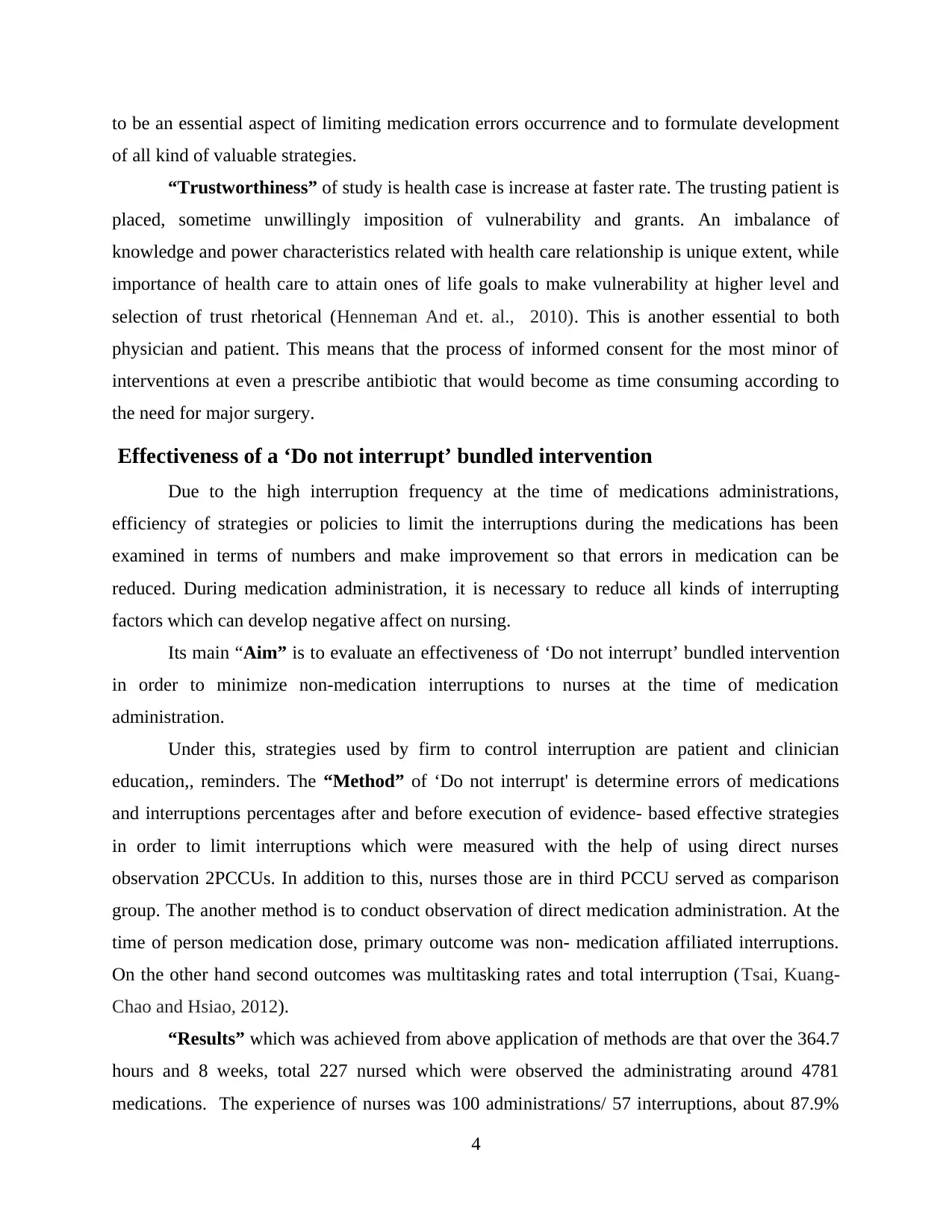
to be an essential aspect of limiting medication errors occurrence and to formulate development
of all kind of valuable strategies.
“Trustworthiness” of study is health case is increase at faster rate. The trusting patient is
placed, sometime unwillingly imposition of vulnerability and grants. An imbalance of
knowledge and power characteristics related with health care relationship is unique extent, while
importance of health care to attain ones of life goals to make vulnerability at higher level and
selection of trust rhetorical (Henneman And et. al., 2010). This is another essential to both
physician and patient. This means that the process of informed consent for the most minor of
interventions at even a prescribe antibiotic that would become as time consuming according to
the need for major surgery.
Effectiveness of a ‘Do not interrupt’ bundled intervention
Due to the high interruption frequency at the time of medications administrations,
efficiency of strategies or policies to limit the interruptions during the medications has been
examined in terms of numbers and make improvement so that errors in medication can be
reduced. During medication administration, it is necessary to reduce all kinds of interrupting
factors which can develop negative affect on nursing.
Its main “Aim” is to evaluate an effectiveness of ‘Do not interrupt’ bundled intervention
in order to minimize non-medication interruptions to nurses at the time of medication
administration.
Under this, strategies used by firm to control interruption are patient and clinician
education,, reminders. The “Method” of ‘Do not interrupt' is determine errors of medications
and interruptions percentages after and before execution of evidence- based effective strategies
in order to limit interruptions which were measured with the help of using direct nurses
observation 2PCCUs. In addition to this, nurses those are in third PCCU served as comparison
group. The another method is to conduct observation of direct medication administration. At the
time of person medication dose, primary outcome was non- medication affiliated interruptions.
On the other hand second outcomes was multitasking rates and total interruption (Tsai, Kuang-
Chao and Hsiao, 2012).
“Results” which was achieved from above application of methods are that over the 364.7
hours and 8 weeks, total 227 nursed which were observed the administrating around 4781
medications. The experience of nurses was 100 administrations/ 57 interruptions, about 87.9%
4
of all kind of valuable strategies.
“Trustworthiness” of study is health case is increase at faster rate. The trusting patient is
placed, sometime unwillingly imposition of vulnerability and grants. An imbalance of
knowledge and power characteristics related with health care relationship is unique extent, while
importance of health care to attain ones of life goals to make vulnerability at higher level and
selection of trust rhetorical (Henneman And et. al., 2010). This is another essential to both
physician and patient. This means that the process of informed consent for the most minor of
interventions at even a prescribe antibiotic that would become as time consuming according to
the need for major surgery.
Effectiveness of a ‘Do not interrupt’ bundled intervention
Due to the high interruption frequency at the time of medications administrations,
efficiency of strategies or policies to limit the interruptions during the medications has been
examined in terms of numbers and make improvement so that errors in medication can be
reduced. During medication administration, it is necessary to reduce all kinds of interrupting
factors which can develop negative affect on nursing.
Its main “Aim” is to evaluate an effectiveness of ‘Do not interrupt’ bundled intervention
in order to minimize non-medication interruptions to nurses at the time of medication
administration.
Under this, strategies used by firm to control interruption are patient and clinician
education,, reminders. The “Method” of ‘Do not interrupt' is determine errors of medications
and interruptions percentages after and before execution of evidence- based effective strategies
in order to limit interruptions which were measured with the help of using direct nurses
observation 2PCCUs. In addition to this, nurses those are in third PCCU served as comparison
group. The another method is to conduct observation of direct medication administration. At the
time of person medication dose, primary outcome was non- medication affiliated interruptions.
On the other hand second outcomes was multitasking rates and total interruption (Tsai, Kuang-
Chao and Hsiao, 2012).
“Results” which was achieved from above application of methods are that over the 364.7
hours and 8 weeks, total 227 nursed which were observed the administrating around 4781
medications. The experience of nurses was 100 administrations/ 57 interruptions, about 87.9%
4
⊘ This is a preview!⊘
Do you want full access?
Subscribe today to unlock all pages.

Trusted by 1+ million students worldwide
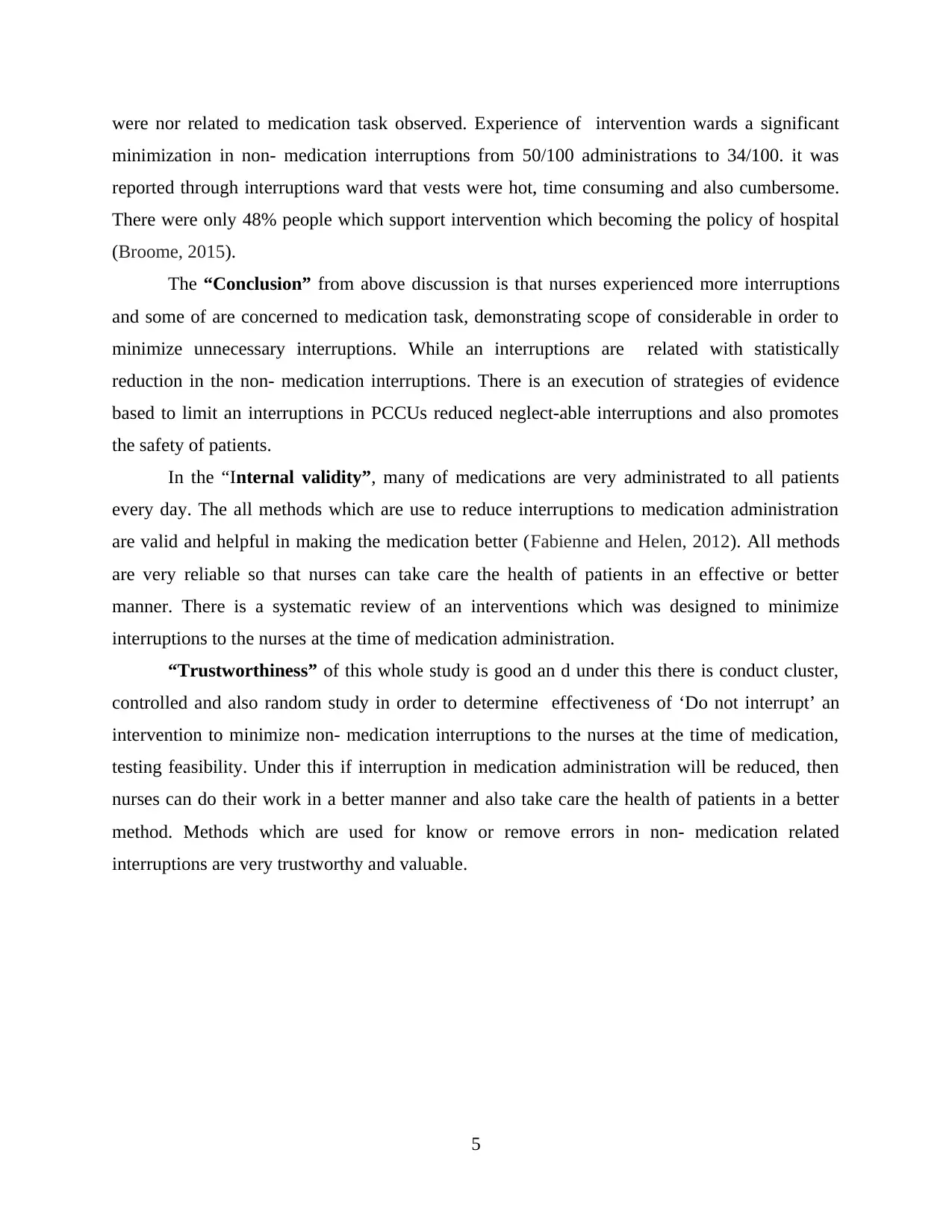
were nor related to medication task observed. Experience of intervention wards a significant
minimization in non- medication interruptions from 50/100 administrations to 34/100. it was
reported through interruptions ward that vests were hot, time consuming and also cumbersome.
There were only 48% people which support intervention which becoming the policy of hospital
(Broome, 2015).
The “Conclusion” from above discussion is that nurses experienced more interruptions
and some of are concerned to medication task, demonstrating scope of considerable in order to
minimize unnecessary interruptions. While an interruptions are related with statistically
reduction in the non- medication interruptions. There is an execution of strategies of evidence
based to limit an interruptions in PCCUs reduced neglect-able interruptions and also promotes
the safety of patients.
In the “Internal validity”, many of medications are very administrated to all patients
every day. The all methods which are use to reduce interruptions to medication administration
are valid and helpful in making the medication better (Fabienne and Helen, 2012). All methods
are very reliable so that nurses can take care the health of patients in an effective or better
manner. There is a systematic review of an interventions which was designed to minimize
interruptions to the nurses at the time of medication administration.
“Trustworthiness” of this whole study is good an d under this there is conduct cluster,
controlled and also random study in order to determine effectiveness of ‘Do not interrupt’ an
intervention to minimize non- medication interruptions to the nurses at the time of medication,
testing feasibility. Under this if interruption in medication administration will be reduced, then
nurses can do their work in a better manner and also take care the health of patients in a better
method. Methods which are used for know or remove errors in non- medication related
interruptions are very trustworthy and valuable.
5
minimization in non- medication interruptions from 50/100 administrations to 34/100. it was
reported through interruptions ward that vests were hot, time consuming and also cumbersome.
There were only 48% people which support intervention which becoming the policy of hospital
(Broome, 2015).
The “Conclusion” from above discussion is that nurses experienced more interruptions
and some of are concerned to medication task, demonstrating scope of considerable in order to
minimize unnecessary interruptions. While an interruptions are related with statistically
reduction in the non- medication interruptions. There is an execution of strategies of evidence
based to limit an interruptions in PCCUs reduced neglect-able interruptions and also promotes
the safety of patients.
In the “Internal validity”, many of medications are very administrated to all patients
every day. The all methods which are use to reduce interruptions to medication administration
are valid and helpful in making the medication better (Fabienne and Helen, 2012). All methods
are very reliable so that nurses can take care the health of patients in an effective or better
manner. There is a systematic review of an interventions which was designed to minimize
interruptions to the nurses at the time of medication administration.
“Trustworthiness” of this whole study is good an d under this there is conduct cluster,
controlled and also random study in order to determine effectiveness of ‘Do not interrupt’ an
intervention to minimize non- medication interruptions to the nurses at the time of medication,
testing feasibility. Under this if interruption in medication administration will be reduced, then
nurses can do their work in a better manner and also take care the health of patients in a better
method. Methods which are used for know or remove errors in non- medication related
interruptions are very trustworthy and valuable.
5
Paraphrase This Document
Need a fresh take? Get an instant paraphrase of this document with our AI Paraphraser
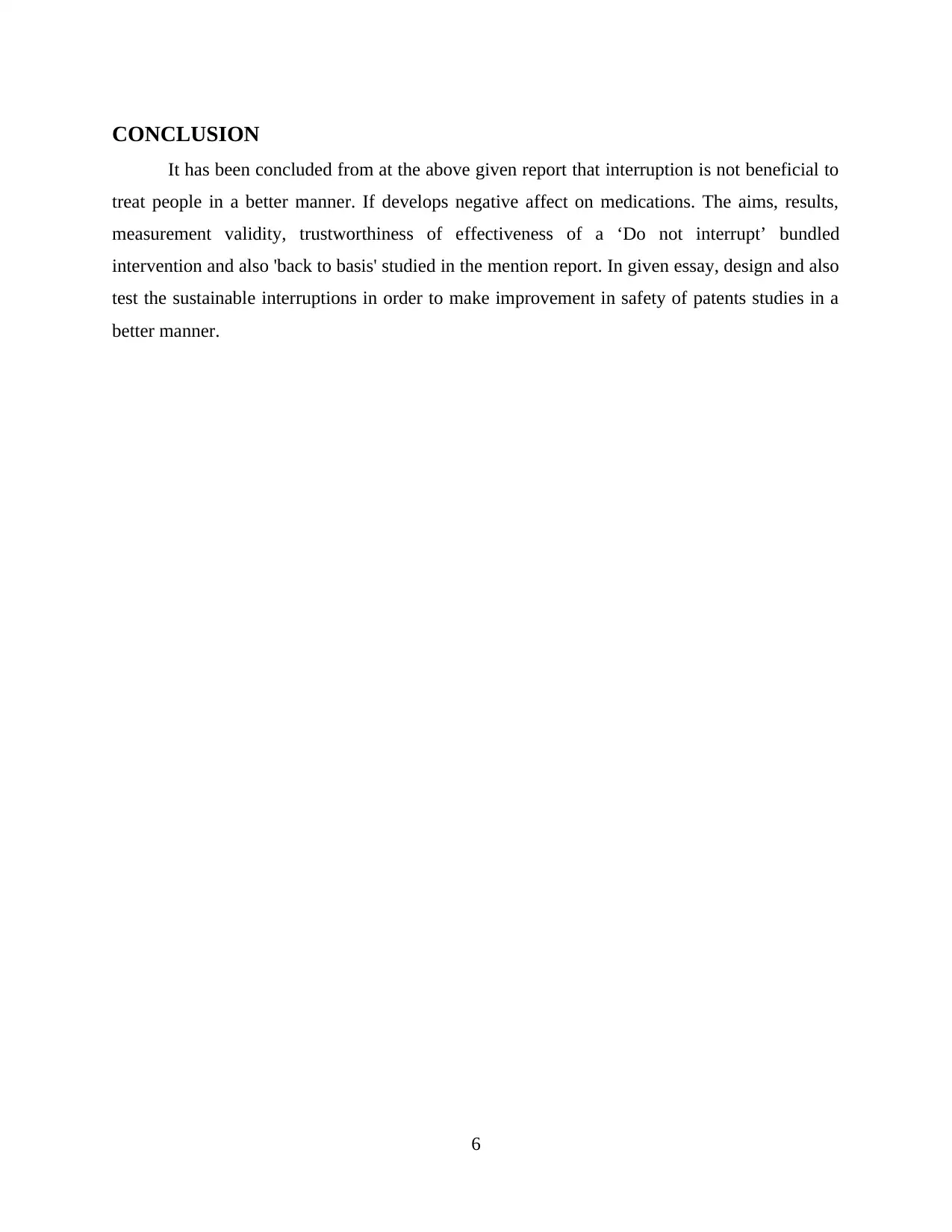
CONCLUSION
It has been concluded from at the above given report that interruption is not beneficial to
treat people in a better manner. If develops negative affect on medications. The aims, results,
measurement validity, trustworthiness of effectiveness of a ‘Do not interrupt’ bundled
intervention and also 'back to basis' studied in the mention report. In given essay, design and also
test the sustainable interruptions in order to make improvement in safety of patents studies in a
better manner.
6
It has been concluded from at the above given report that interruption is not beneficial to
treat people in a better manner. If develops negative affect on medications. The aims, results,
measurement validity, trustworthiness of effectiveness of a ‘Do not interrupt’ bundled
intervention and also 'back to basis' studied in the mention report. In given essay, design and also
test the sustainable interruptions in order to make improvement in safety of patents studies in a
better manner.
6
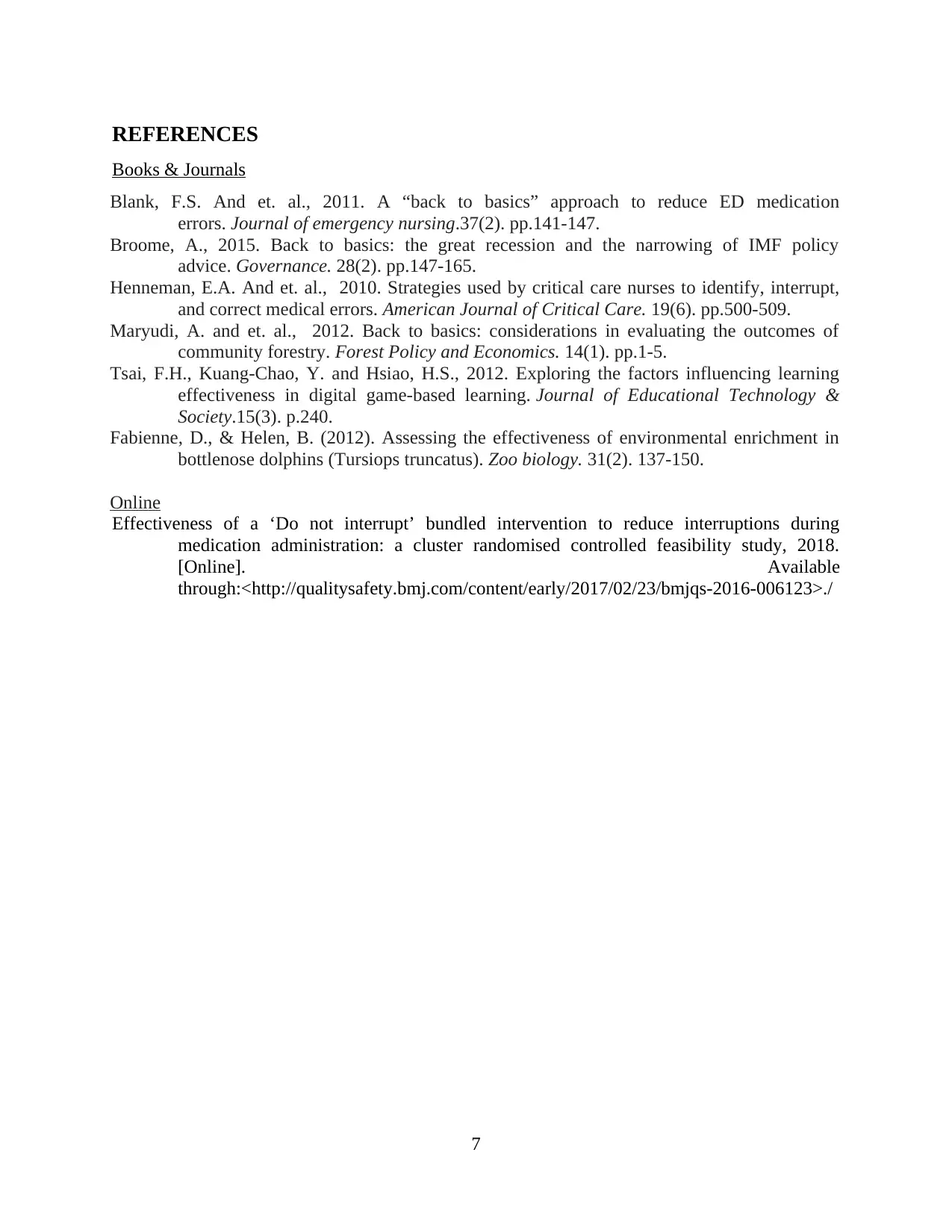
REFERENCES
Books & Journals
Blank, F.S. And et. al., 2011. A “back to basics” approach to reduce ED medication
errors. Journal of emergency nursing.37(2). pp.141-147.
Broome, A., 2015. Back to basics: the great recession and the narrowing of IMF policy
advice. Governance. 28(2). pp.147-165.
Henneman, E.A. And et. al., 2010. Strategies used by critical care nurses to identify, interrupt,
and correct medical errors. American Journal of Critical Care. 19(6). pp.500-509.
Maryudi, A. and et. al., 2012. Back to basics: considerations in evaluating the outcomes of
community forestry. Forest Policy and Economics. 14(1). pp.1-5.
Tsai, F.H., Kuang-Chao, Y. and Hsiao, H.S., 2012. Exploring the factors influencing learning
effectiveness in digital game-based learning. Journal of Educational Technology &
Society.15(3). p.240.
Fabienne, D., & Helen, B. (2012). Assessing the effectiveness of environmental enrichment in
bottlenose dolphins (Tursiops truncatus). Zoo biology. 31(2). 137-150.
Online
Effectiveness of a ‘Do not interrupt’ bundled intervention to reduce interruptions during
medication administration: a cluster randomised controlled feasibility study, 2018.
[Online]. Available
through:<http://qualitysafety.bmj.com/content/early/2017/02/23/bmjqs-2016-006123>./
7
Books & Journals
Blank, F.S. And et. al., 2011. A “back to basics” approach to reduce ED medication
errors. Journal of emergency nursing.37(2). pp.141-147.
Broome, A., 2015. Back to basics: the great recession and the narrowing of IMF policy
advice. Governance. 28(2). pp.147-165.
Henneman, E.A. And et. al., 2010. Strategies used by critical care nurses to identify, interrupt,
and correct medical errors. American Journal of Critical Care. 19(6). pp.500-509.
Maryudi, A. and et. al., 2012. Back to basics: considerations in evaluating the outcomes of
community forestry. Forest Policy and Economics. 14(1). pp.1-5.
Tsai, F.H., Kuang-Chao, Y. and Hsiao, H.S., 2012. Exploring the factors influencing learning
effectiveness in digital game-based learning. Journal of Educational Technology &
Society.15(3). p.240.
Fabienne, D., & Helen, B. (2012). Assessing the effectiveness of environmental enrichment in
bottlenose dolphins (Tursiops truncatus). Zoo biology. 31(2). 137-150.
Online
Effectiveness of a ‘Do not interrupt’ bundled intervention to reduce interruptions during
medication administration: a cluster randomised controlled feasibility study, 2018.
[Online]. Available
through:<http://qualitysafety.bmj.com/content/early/2017/02/23/bmjqs-2016-006123>./
7
⊘ This is a preview!⊘
Do you want full access?
Subscribe today to unlock all pages.

Trusted by 1+ million students worldwide
1 out of 9
Related Documents
Your All-in-One AI-Powered Toolkit for Academic Success.
+13062052269
info@desklib.com
Available 24*7 on WhatsApp / Email
![[object Object]](/_next/static/media/star-bottom.7253800d.svg)
Unlock your academic potential
Copyright © 2020–2025 A2Z Services. All Rights Reserved. Developed and managed by ZUCOL.




